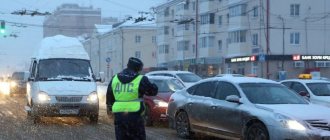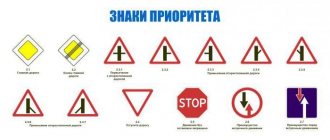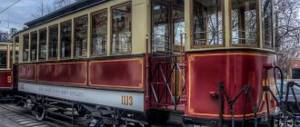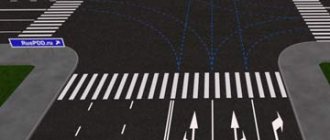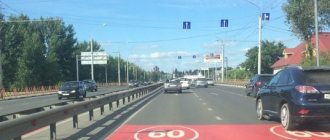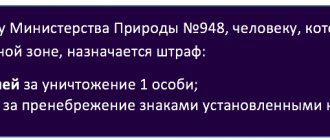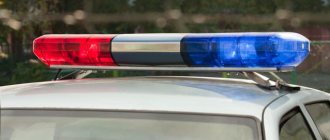Hello, friends! Today we are talking about what is the main road at the crossroads.
Situations vary. In most cases, intersections are equipped with the necessary signs and indicators. Based on them, you can answer the question posed, and then make the right maneuver.
But it also happens that there are no signs. And in such a situation it is not entirely clear how to look at the main road.
To simplify the task, we will consider several situations and try to answer pressing questions.
We focus on the signs
To understand who is on the main road and who is on the secondary road, you need to look at the signs.
From a distance it is not always possible to understand what is considered the main road at an upcoming intersection.
In this situation, it is recommended to slow down and also drive closer.
Next, look for possible signs. They will help if the traffic light is faulty or there is no traffic controller.
Look at the signs at the intersection. And remember driving courses. This is basic knowledge that all motorists must have.
Sign 2.1
Directly indicates which road is the main one. Means "Main Road".
If you see this sign, then there is an intersection of unequal roads ahead. Therefore, you move along the main road. You have priority. Use it correctly.
Sign 2.4
It also helps to understand which road is the main one at the intersection. Not yours. After all, this sign informs you to give way. Presented in the form of an inverted triangle.
Consequently, the driver is moving on a secondary road. The path itself is uneven.
If necessary, in case of such a sign you will have to stop. This is necessary to give way to drivers with priority.
Sign 2.5
Another useful sign. It doesn’t mean that you can’t move without stopping.
Also a sign of being on the road of secondary importance. You will need to stop before the stop line. If it exists, of course.
If there is no line, you must stop in front of the edge of the roadway. This will allow you to assess the situation and make the right decision on subsequent maneuvers.
You need to give way to vehicles moving on the side with priority. Only after this is it allowed to continue on your own path.
Driving without stopping is prohibited
The no-stop sign is a “strengthened” version of the give way sign:
It differs from the previous sign in that the driver must stop before the stop line or the edge of the roadway being crossed.
In addition to intersections, the sign can also be installed in front of railway crossings. In this case, the driver should stop in front of the stop line, and if there is no stop line, in front of the sign itself.
As a rule, the sign “driving without stopping is prohibited” is installed before intersections with limited visibility, where a large number of traffic accidents occur, so it should not be ignored in any case.
When you can't see the signs
If there are no road signs on your side, you should definitely slow down.
Look around carefully. Do you see signs on other sides of the intersection?
They are often duplicated on the left side. Or they hang it above the road, rather than installing it on poles on the side.
Moreover, in some situations they are installed in such a way that it is impossible to notice them. Bushes and tree branches become a common obstacle. Utility services are clearly underperforming. And the priority signs are hidden in the branches.
The only bad thing is that this fact is unlikely to exempt you from liability for violating the rules of crossing an intersection. So be careful. Look around.
If you haven’t seen the signs on your side, then take a closer look at their possible placement on other sides of the approaching intersection.
It’s not difficult to recognize the signs from the reverse side:
- the main road is represented as a diamond;
- you need to give way to an inverted triangle;
- You can’t move without stopping if it’s an octagon.
Having seen one of the presented signs at one of the corners of the intersection, the driver can correctly assess the situation and also make a decision on subsequent maneuvers.
Coverage to help
Another situation where the main road is how to determine without signs.
In such a situation, it makes sense to evaluate the road surface.
More relevant outside populated areas. There are also possible intersections where priority signs are not installed.
There is a simple solution. This is the presence of a ground cover. Where the soil intersects with asphalt, everything is elementary. The soil is a secondary area, and the asphalt is a priority, that is, the main one.
Yes, asphalt can also be applied over a certain number of meters from the ground side. But only for aesthetics. The presence of a piece of asphalt on the ground when crossing an intersection does not make both roads equal. Consequently, the driver leaving the dirt must yield and let those driving on the asphalt surface pass.
Concept and meaning
The concept of a main road is established by the definition of traffic rules. According to the law, the main road is a section of the roadway on which priority of passage is established relative to secondary roads. A secondary road is a road adjacent to or intersecting the main one. These are all kinds of access routes, alleys, driveways and other routes.
As a rule, the main road is marked with specially designated road signs. And also the main part is the part that has a hard coating in relation to the primer.
A priority sign installed in front of an intersection gives the right of priority passage only at that intersection. It is often duplicated at subsequent intersections. Therefore, to determine the coverage area, another sign is installed - a crossed out yellow diamond, which means that the main road ends, but it is not placed in every case.
When there is an intersection after a crossed out sign, according to the rules it is considered equivalent. In this case, the right of passage is determined by an obstacle on the right or by the surface of the roadway. If the road is covered with asphalt and wide, it is the main one, and if it is covered with a primer, then the driver must give way when driving along it.
The end of the main road sign, combined with a yield sign, means that the motorist is obliged to allow other drivers to pass.
It is known that priority signs cannot prohibit any actions by drivers, but only indicate who has priority when driving through uncontrolled intersections. But the main road sign, installed outside populated areas, prohibits standing on this section. That is, you cannot stop in the middle of the highway for personal needs, the only exception being emergency situations. In case of violation, you will face administrative punishment. Therefore, wait until parking spots appear on the way and park calmly.
It is possible to install a sign together with a sign indicating the direction. This is done where equal and unequal intersections intersect. This combination also regulates the movement of pedestrians and is installed together with the designation of a pedestrian crossing. When approaching such intersections, you must slow down in advance and be more careful. The absence of a direction sign indicates the straightness of the road.
Many drivers find it difficult to organize their actions when changing direction. The fact is that when they see a sign defining the main road, they assume the right of way. But what to do in a situation where two motorists standing on opposite sides of the intersection believe that they have the right to pass?
How to act when changing the direction of the main road at an intersection:
- When moving, think not only about yourself, but also about other motorists. Take a closer look at the addition - plate 8.13, indicating the direction.
- Visually position the sign in the center of the intersection, then you will see that the wide stripe shows the priority road, and the narrow stripes show the secondary road.
- Having excluded the thin stripes “in the head”, leave only the main part in mind. Then the second participant in the movement and you will act according to the rule of interference on the right. The one who has no obstacle starts the movement.
In the same way, you can mentally divide the site into two halves for travel.
What to do if there are no signs
Let's look at the following situation. There are no priority signs on the driver's side.
Then it makes sense to refer to paragraph 13.13 of the traffic rules.
It says the following. When a motorist is unable to determine the surface and there are no priority signs, he should assume that he is driving on a secondary route.
The inability to determine the coverage is determined by poor lighting, the presence of snow, dirt, etc.
It turns out the following. When the driver cannot determine the status of the road, then you need to act on the basis that you are on a secondary route. And if sign 2.4 is visible ahead, but is turned backwards, then when crossing this road will be the main one. There are no options here.
The priority should always be to assess vehicles that are on a potential main road. See how many there are and how far they are from you. They have an advantage. Therefore, if vehicles are close, you will need to let them through.
As for oncoming cars, you have equal rights. After all, both cars are moving on a secondary road. What follows from this? If the car opposite is about to turn left, then first it must let you pass, moving straight.
There is just a nuance. Use priority only if you are sure that the oncoming vehicle intends to yield.
Ticket 36 question 3 17% wrong
Which car drivers violated parking rules?
Only car B Cars A and B Only car A
The effect of sign 3.27 “Stopping is prohibited” extends to the nearest intersection. In this case, to the intersection with the road adjacent to the left. You can park the car in place “B”. Only the driver of car “A” violates the rules of stopping and parking. (“Road signs”, paragraph 12.1 of traffic rules). The correct answer is “Only car A”
Topics of the question (solve them if you have any difficulties in this matter):
- Road signs
- Stopping and parking
Hint Further Discuss (137)
Ticket 36 question 13 30% wrong
You intend to turn right. Your actions?
Give way to a car making a U-turn Wait for another signal from the traffic controller Pass the intersection first
From the side of the traffic controller's outstretched right hand, trackless vehicles are only allowed to move to the right. At the same time, the turning car, guided by the “right-hand rule,” gives way to you. (Clause 6.10 of the Traffic Regulations). The correct answer is “Go through the intersection first.”
Topics of the question (solve them if you have any difficulties in this matter):
- Driving through intersections
- Traffic lights and traffic controller signals
Hint Further Discuss (24)
Ticket 36 question 16 10% wrong
You are required to give way to a truck:
In both of the above cases Only when turning right Only when turning left
You are leaving a residential area, as indicated by sign 5.22 “End of a residential area.” You give way to other road users, in this situation - to a truck in both of the above cases. (“Road signs”, clause 17.3 of traffic regulations). The correct answer is “In both of the above cases”
Topics of the question (solve them if you have any difficulties in this matter):
- Traffic in residential areas
Hint Further Discuss (2)
Ticket 36 question 20 13% wrong
How does a driver perceive the speed of his car when driving for a long time on a flat road at high speed?
Appears less than in reality Perception of speed does not change Appears greater than in reality
The driver determines the speed of movement by the speed of movement of objects falling into his field of vision. During long monotonous movement, the speed seems less than in reality. To control your speed in such situations, use the speedometer more often than usual. The correct answer is “It seems smaller than in reality.”
Topics of the question (solve them if you have any difficulties in this matter):
- Traffic safety and driving techniques
Hint Further Discuss
Ticket 36 question 4 26% wrong
Which of the indicated plates extend the effect of the signs installed with them to trucks with a permissible maximum weight of not more than 3.5 tons?
B and C Only B All Only C
Plates 8.4.1 (A) and 8.4.3 (B) “Type of vehicle” apply to: “A” – to trucks, including those with a trailer, with r.m.m. more than 3.5 tons, “B” - for cars, as well as trucks with r.m.m. up to 3.5 tons. Plate 8.6.1 (B) “Method of parking a vehicle” extends the effect of sign 6.4 “Parking (parking space)” to ALL vehicles. Therefore, only plates “B” and “C” apply to trucks, r.m.m. of which no more than 3.5 tons (“Road signs”). The correct answer is “B and C”
Topics of the question (solve them if you have any difficulties in this matter):
- Road signs
Hint Further Discuss (4)
Ticket 36 question 5 4% wrong
The right lane is intended for traffic:
All buses and trolleybuses Buses and trolleybuses moving along established routes with designated stopping places, as well as school buses and passenger taxis Any buses
On the rightmost lane, marked with markings in the form of the letter “A” and sign 5.14 “Lane for route vehicles” from those listed in the answers of T.S. Buses and trolleybuses moving along established routes with designated stopping places, related to route vehicles, as well as school buses and passenger taxis have the right to operate. (Clause 1.2 of the Traffic Regulations, “Road signs”, “Horizontal markings”). The correct answer is “Buses and trolleybuses moving along established routes with designated stopping places, as well as school buses and passenger taxis”
Topics of the question (solve them if you have any difficulties in this matter):
- Road markings
- Road signs
Hint Further Discuss
Ticket 36 question 10 13% wrong
In what cases, on roads whose roadways are divided by marking lines, are drivers required to drive strictly along the lanes?
Only if lanes are marked with solid lines Only in heavy traffic In all cases
If there are markings, traffic is carried out strictly along the designated lanes in all cases. (Clause 9.7 of the Traffic Regulations). The correct answer is “In all cases”
Topics of the question (solve them if you have any difficulties in this matter):
- Location of vehicles on the roadway
Hint Further Discuss (9)
Ticket 36 question 18 34% wrong
Administrative liability is established for violation of traffic rules or vehicle operating rules, resulting in the following:
Minor or moderate harm to human health Minor or moderate harm to human health or material damage Minor harm to human health or minor material damage
In accordance with Art. 12.24 of the Code of Administrative Offenses, administrative liability is established for violations of traffic rules or vehicle operating rules that result in causing minor or moderate harm to human health. "Code of the Russian Federation on Administrative Offences". The correct answer is “Mild or moderate harm to human health”
Topics of the question (solve them if you have any difficulties in this matter):
- Driver's responsibility
Hint Further Discuss (3)
Ticket 36 question 19 20% wrong
How to properly perform emergency braking on a slippery road if the car is not equipped with an anti-lock braking system?
Brake by intermittently pressing the brake pedal, without allowing the wheels to lock Press the brake pedal all the way and hold it until it stops Press the brake pedal while simultaneously using the parking brake
Emergency, non-service, braking on a slippery surface should be done in combination, i.e. by “engine braking” (without disengaging the clutch until the speed drops significantly) and intermittently pressing the brake pedal, avoiding complete blocking of the wheels, which will result in “skidding” and increase in braking distance. The main mistake in this case is holding the pedal for a long time, that is, the inability to brake impulsively (intermittently). The correct answer is “Brake by intermittently pressing the brake pedal, preventing the wheels from locking.”
Topics of the question (solve them if you have any difficulties in this matter):
- Traffic safety and driving techniques
Hint Further Discuss (2)
Ticket 36 question 6 7% wrong
What should a passenger car driver do when an emergency service vehicle approaches?
Change to the right lane Continue driving in the left lane Stop on the right side at the sidewalk
Emergency service vehicles driving with a blue flashing light and a special sound signal on should give way, ensuring unobstructed passage. The driver of a passenger car should change lanes to the right and continue driving. (Clause 3.2 of the Traffic Regulations). The correct answer is “Move to the right lane”
Topics of the question (solve them if you have any difficulties in this matter):
- Application of special signals
Hint Further Discuss (5)
Ticket 36 question 11 11% wrong
The driver of the vehicle being overtaken:
Has the right to act at his own discretion Obligated not to increase the speed of movement Obliged to reduce the speed of movement
The driver of an overtaken vehicle is prohibited from impeding overtaking by increasing the speed or taking other actions. (Clause 11.3 of the Traffic Regulations). The correct answer is “Obligated not to increase the speed of movement”
Topics of the question (solve them if you have any difficulties in this matter):
- Overtaking, advancing, oncoming traffic
Hint Further Discuss (1)
Ticket 36 question 17 11% wrong
When is it necessary to turn on low beam headlights or daytime running lights during daylight hours?
Only when driving outside a populated area In both of the above cases Only when driving in a populated area
Low beam headlights or daytime running lights during daylight hours must be turned on in both of these cases. (Clause 19.5 of the Traffic Regulations.) The correct answer is “In both of the above cases”
Topics of the question (solve them if you have any difficulties in this matter):
- Use of external lighting devices and sound signals
Hint Further Discuss
Ticket 36 question 12 30% wrong
Are you allowed to stop to disembark passengers at the specified location?
Allowed if it does not interfere with the movement of route vehicles Allowed Prohibited
In populated areas on roads with one lane in each direction, without tram tracks in the middle, stopping and parking is allowed not only on the right side, but also on the left in the direction of travel. Stopping to disembark and pick up passengers is permitted at stopping places for route vehicles, marked with zigzag markings 1.17, if this stop does not interfere with their movement. (“Road signs”, clauses 12.1, 12.4 of traffic regulations). The correct answer is “Allowed if it does not interfere with the movement of route vehicles.”
Topics of the question (solve them if you have any difficulties in this matter):
- Stopping and parking
Hint Further Discuss (23)
Ticket 36 question 9 16% wrong
If the trajectories of vehicles intersect, and the order of passage is not specified by the Rules, you should:
Give way to a vehicle approaching from the right Give way to a vehicle approaching from the left Act as mutually agreed upon by the drivers
In cases not specified by the Rules, and this is, for example, in the areas of parking lots, gas stations, factories, in fields, meadows, etc., the order of passage is determined by the “right-hand rule,” i.e. whoever has an obstacle on the right concedes. (Clause 8.9 of the Traffic Regulations). The correct answer is “Give way to a vehicle approaching from the right.”
Topics of the question (solve them if you have any difficulties in this matter):
- Start of movement, maneuvering
Hint Further Discuss (18)
Ticket 36 question 8 13% wrong
You can continue driving when turning left:
Along any trajectory from those indicated Only along trajectory B Only along trajectory A
When turning left at an intersection, you can choose any direction of movement. The main condition is that when leaving the intersection of roadways, your vehicle should not end up on the side of oncoming traffic. (Clause 8.6 of the Traffic Regulations). The correct answer is “Along any of the indicated paths”
Topics of the question (solve them if you have any difficulties in this matter):
- Start of movement, maneuvering
Hint Further Discuss (5)
